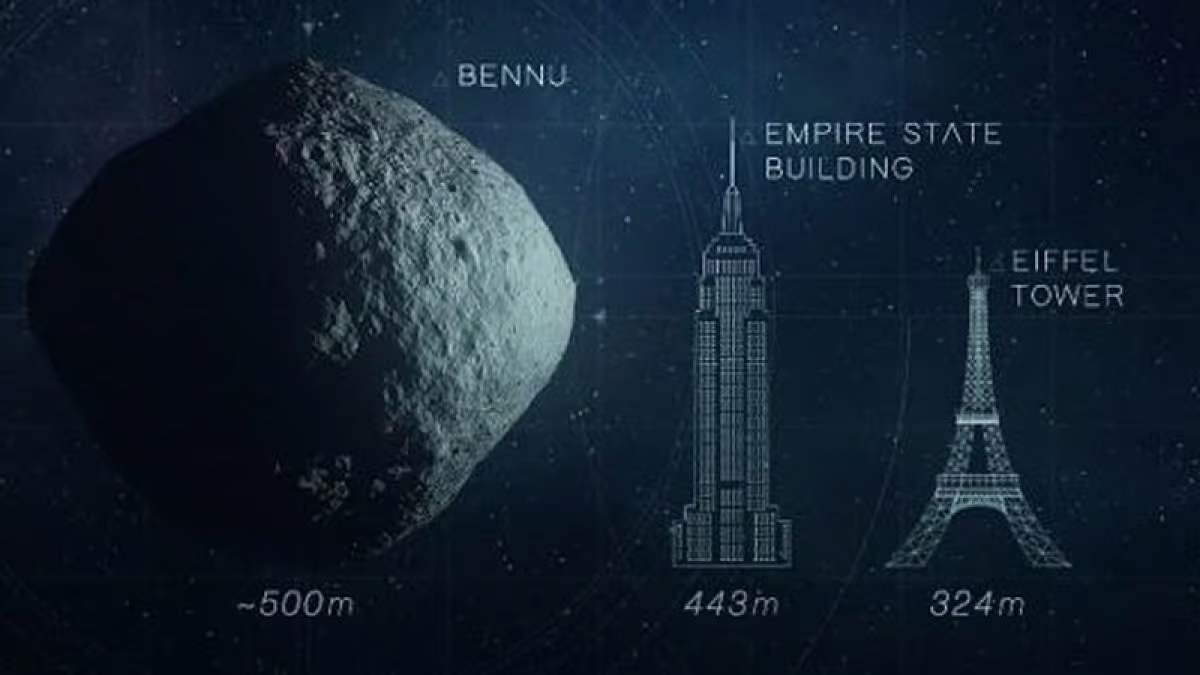25.09.2023

Asteroid Bennu could one day hit Earth and US-funded space agency NASA have designed a spacecraft to knock it off course or blow it up using nuclear weapons. Picture: NASA. (NASA Goddard Space Flight Center Conceptual Image Lab)
As excited observers gear up for the possible return of asteroid chips in the next few days, attention turns again to the prospect of going to the Moon and other planetary bodies in search of natural resources.
Vast amounts of the most vital natural resources we use on Earth exist on nearby planetary bodies.
Water, gases and minerals are on the Moon, (as well as comets and asteroids) in large quantities, offering an ambitious option to meet increasing terrestrial demand.
In 1969, rocks were brought back from the Moon and, decades later, two Japanese spacecraft successfully landed on asteroids and collected dust grains, first in 2005 and again in 2019.
On September 24, a NASA spacecraft — the OSIRIS-REx — will return to Earth hopefully with samples from the asteroid Bennu, after collecting about 60 grams of the asteroid’s surface material, which was placed in a Sample Return Capsule (SRC) for the journey back to Earth.
Bennu is a carbonaceous asteroid in the Apollo group discovered by the LINEAR Project on 11 September 1999. This small, near-Earth asteroid passes close to Earth about every six years so it’s better known as a potentially hazardous object. NASA tracks Bennu, and says there is a one in 2,700 chance it will come into contact with Earth on September 21, 2135.
In the meantime minds turn to space mining which is still in its infancy, but governments and private entities are gearing up now for first-mover advantage.
Serkan Saydam, Andrew Dempster, University of New South Wales in Sydney were part of an editorial team which this week reported as follows for 360info.org.
The drive to explore deeper into space and establish colonies on other planets has intensified over the last decade, and with it the importance of space resources extraction.
Obtaining valuable resources and minerals, even in extreme environments, has long been attractive to humans. We have a history of facing hazards in search of valuable resources. From the gold rush in the 1800s to the recent surge in space resources, humans have been willing to take risks to find and collect scarce and profitable materials.
With advances in space technology, we’re on the edge of the next gold rush. Off-Earth mining is expected to begin in the next decade.
Potential sites include the Moon, Mars and its moons, asteroids and even comets.
NASA’s Artemis program, which Australia supports via its signing of the Artemis Accords, is aiming for a lunar colony and eventually one on Mars. The only way to reduce the enormous costs of transporting resources from Earth will be through the establishment of self-sustaining infrastructure.
Water is an essential starting point. When converted to oxygen and hydrogen, it can be used as a propellant for rockets for further space missions. The vast reserves of lunar ice suggest it’s a sustainable and economical source compared with Earthly transport.
The Australian Centre for Space Engineering Research, based at the University of New South Wales, merges terrestrial mining engineering expertise with space research.
Australia could be positioned as a global leader in in-situ resource utilisation by harnessing space resources to reduce potential risks of off-Earth mining. This encompasses using lunar regolith (soil) for construction or mineral extraction, focusing on lunar water.
However, off-Earth mining has many challenges: there are geological uncertainties — we don’t know exactly where the water is and how much there is; infrastructural needs such as landing pads; social considerations — people have a strong emotional attachment to the moon; and financial constraints, with high risk but high potential return.
Mining is a challenging industry that constantly confronts extreme conditions and volatile markets. Despite these obstacles, mining has continued to attract businesses due to the potential for high financial returns. In many cases, mining operations have been a driving force behind the settlement of new territories.
Looking towards the future, the mining industry is working towards zero-entry mines (with no human access required) and invisible mines (low-impact, reduced-footprint mining sites) to reduce the effect on the environment, improve energy efficiency and achieve decarbonisation.
Improved social acceptance and reputation are also critical for the mining industry’s future. The space resources industry is motivated by colonisation and creating a market for its product.
The mining and space sectors both thrive in challenging environments, making collaboration essential. They can mutually benefit, with the mining sector gaining from systems engineering and autonomous technology, while space can leverage operational experience and market creation.
The path ahead is loaded with uncertainties, but merging mining knowledge with space exploration will be paramount in the years ahead.
Quelle: COSMOS

